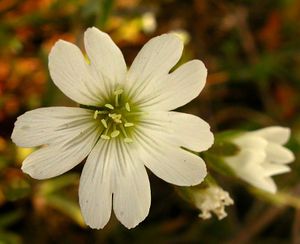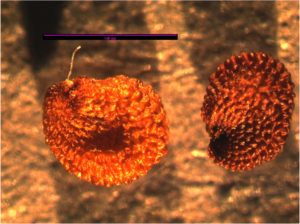Cerastium arvense
- Scientific Name: Cerastium arvense
- Family: Caryophyllaceae
- Common Names: starry cerastium, field chickweed, field mouse-ear chickweed
- Codon: CERARV
Contents
Taxonomy
| Scientific classification | |
|---|---|
| Kingdom: | Plantae |
| Subkingdom: | Viridiplantae |
| Phylum: | Tracheophyta |
| Subphylum: | Spermatophytina |
| Class: | Magnoliopsida |
| Subclass: | Caryophyllanae |
| Order: | Caryophyllales |
| Family: | Caryophyllaceae |
| Genus: | Cerastium L. |
| Species: | Cerastium arvense L. |
Description
Tufted, often mat-forming perennial herb with opposite leaves and showy white flowers, to 50 cm tall.[2] Leaves narrow, 1-nerved, 1 to 3 cm long.[3] Inflorescences open cymose, bracteate, short-pubescent,[4] with 3 to 5 flowers.[3] Flowers 5-merous, regular; sepals 5, distinct; petals 5, bilobed,[5] stamens 10[2]; styles 5, ovary superior, becoming a cylindrical, membranous capsule.[2]
Bloom Period
April - August[2]
Distribution
Both sides of the Cascades and in the Blue Mountains in Washington. Widely distributed throughout North America.[2]
Habitat
Coastal cliffs to inland valleys, rocky hillsides, subalpine meadows.[2]
Uses
Pollinated by butterflies and moths.[6]
The plant is astringent. First Nation use as a decoction in the treatment of injuries and miscarriage.[7]
Propagation
It is suggested that the seed be sown in spring in a cold frame. When they are large enough to handle, prick the seedlings out into individual pots and plant them out into their permanent positions in the summer. Division in spring. The prostate shoots root freely as they spread, making division very simple.[8]
Seed
Seed sample from: 2011
Average Measurement: 0.9 x 0.9 x 0.5
Measurement Range: L: 0.75 – 1, W: 0.8 – 1, D: 0.4 – 0.6
Shape: Seed somewhat kidney shaped, narrower at hilum and broadening at opposite apex. Hilum pinched.
Color: Rusty brown to orange brown. Hilum white.
Surface: Matte and covered with many small bumps, arranged in concentric half circles originating at the hilum and broadening at the opposite apex.
Latitudinal Cross Section: elliptical ![]()
Longitudinal Cross Section: obovate ![]()
Basic Explanations and Assumptions:
The dimensions for the seeds are length x width x depth. The location of the hilum is used as the base of the seed, and the length is measured from hilum to the opposite apex. Where a style is present, the length is measured from the hilum to the bottom of the style. Width is measured at a right angle to the length at the widest part. Depth is measured at a right angle to the intersection of height and width lines.
Measurements included are the mean average for each measurement of ten separate seeds.
All measurements in millimeters unless otherwise noted.
Photo Gallery
References
- ↑ Integrated Taxonomic Information System. Retrieved from https://www.itis.gov/servlet/SingleRpt/SingleRpt?search_topic=TSN&search_value=19947
- ↑ 2.0 2.1 2.2 2.3 2.4 2.5 WTU Herbarium, Burke Museum, & University of Washington. Retrieved from https://biology.burke.washington.edu/herbarium/imagecollection/taxon.php?Taxon=Cerastium%20arvense
- ↑ 3.0 3.1 Bowcutt, F., & Hamman, S. (2016). Vascular Plants of the South Sound Prairies. p. 82.
- ↑ Flora of North America. Retrieved from http://dev.floranorthamerica.org/Cerastium_arvense
- ↑ Hitchcock, C. L., Cronquist, A., Giblin, D., & Legler, B. et al. (2018). Flora of the Pacific Northwest: an illustrated manual. Seattle: University of Washington Press. p. 341
- ↑ Washington Native Plant Society. Retrieved from https://www.wnps.org/component/rsdirectory/entry/view/85-cerastium-arvense&highlight=WyJjZXJhc3RpdW0iLCJhcnZlbnNlIiwiY2VyYXN0aXVtIGFydmVuc2UiXQ==
- ↑ Native American Ethnobotany Database. Retrieved from http://naeb.brit.org/uses/search/?string=Cerastium+arvense
- ↑ Plants for a Future. Retrieved from https://pfaf.org/user/Plant.aspx?LatinName=Cerastium



